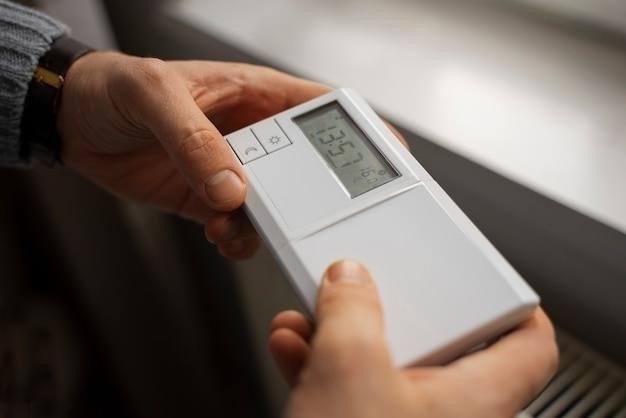Danfoss Radiator Thermostat⁚ A Comprehensive User Guide
This guide provides a complete overview of Danfoss radiator thermostats, covering various models, installation procedures, operation, advanced features, troubleshooting, battery replacement, energy-saving tips, and essential safety precautions. Learn how to optimize your home’s heating system for comfort and efficiency with your Danfoss thermostat.
Understanding Danfoss Thermostat Models
Danfoss offers a range of radiator thermostats catering to diverse needs and preferences. Mechanical thermostats provide basic temperature control via a dial, offering simplicity and reliability. These are ideal for straightforward temperature regulation without smart features. Electronic thermostats, such as the Danfoss Eco, offer programmable scheduling and often connect to smartphone apps for remote control and advanced features like geo-fencing and energy monitoring. The Danfoss RA2000 represents another popular model known for its tamper-resistant design, perfect for households with children or pets. Consider factors like your budget, technical expertise, and desired level of control when selecting a Danfoss thermostat. Each model provides detailed instructions; refer to your specific model’s manual for precise operational guidance; The choice depends on your home’s heating system and your personal preferences for convenience and energy management. Smart thermostats offer significant energy-saving potential through intelligent scheduling and remote control capabilities. Before installation, ensure compatibility with your existing radiator valves to guarantee seamless integration and proper functionality. Understanding these differences ensures you choose the right thermostat to meet your needs. Consult the Danfoss website or a qualified installer for further assistance in selecting the optimal model for your home.
Installation Guide⁚ Step-by-Step Instructions

Installing your Danfoss radiator thermostat typically involves several key steps. First, turn off the heating system to prevent accidental scalding. Next, carefully remove the old thermostat, if applicable, noting its connection type for compatibility with the new unit. Danfoss provides various adapter options to ensure compatibility with different valve types; select the correct adapter based on your radiator valve. Attach the adapter securely to the valve, ensuring a firm and leak-free connection. Then, carefully position the new Danfoss thermostat onto the valve, aligning it correctly and pushing it firmly until you hear a distinct click, indicating secure placement. For electronic thermostats, insert the batteries according to the instructions provided. After installation, turn the heating system back on and verify proper functionality by monitoring the radiator’s temperature response to the thermostat’s settings. Refer to your specific Danfoss thermostat model’s instructions for detailed diagrams and precise guidance. If you encounter difficulties or are uncertain about any step, consult a qualified heating professional for assistance. Improper installation may affect the thermostat’s performance and could potentially damage your heating system. Always prioritize safety during installation and operation.
Operating Your Danfoss Thermostat⁚ Basic Controls
Operating your Danfoss thermostat is generally intuitive, but specifics vary depending on the model. Most Danfoss thermostats feature a simple dial or digital display for temperature adjustment. To increase or decrease the room temperature, rotate the dial or use the up/down buttons on the digital display. The desired temperature is usually displayed prominently. Many models offer a manual override function, allowing temporary adjustment outside of the programmed schedule. This is often achieved by pressing and holding a specific button. Some Danfoss thermostats include a “frost protection” setting, which maintains a minimum temperature to prevent freezing pipes during periods of inactivity. Activating this feature might involve a specific button or menu option. Always consult your model’s user manual for detailed instructions on basic controls and additional features. Understanding these basics will enable you to effortlessly manage your room’s temperature, promoting comfort and energy efficiency. Remember, improper operation can lead to suboptimal heating performance, so familiarize yourself with your model’s specific controls.
Advanced Features and Settings
Beyond basic temperature control, many Danfoss thermostats offer sophisticated features enhancing comfort and energy efficiency. Programmable models allow you to schedule different temperatures for various times of the day or days of the week, optimizing heating according to your routine. This often involves navigating a menu system on the thermostat’s display, setting desired temperatures for specific time slots. Some advanced models integrate with smart home systems, enabling remote control and monitoring via a smartphone app. This allows adjustments from anywhere with an internet connection, enhancing convenience and control. Features like open window detection automatically reduce heating when a sudden drop in temperature is sensed, preventing energy waste. Others offer adaptive learning capabilities, automatically adjusting the heating schedule based on your usage patterns. These advanced settings usually require initial configuration through the thermostat’s menu, sometimes requiring consultation of the user manual. Exploring these features can significantly improve your home’s energy efficiency and overall comfort, though the availability of advanced functions depends on the specific Danfoss thermostat model.
Troubleshooting Common Issues
If your Danfoss thermostat malfunctions, several troubleshooting steps can help resolve common problems. A non-responsive display might indicate low batteries; replace them following the instructions in the user manual. If the thermostat isn’t regulating temperature correctly, check the valve connection for proper seating and ensure the radiator is not blocked by furniture or curtains, impeding heat distribution. Inconsistent heating might result from airlocks in the radiator; bleed the radiator to release trapped air, following the instructions for your specific heating system. If the thermostat displays an error code, consult the user manual for a detailed explanation and suggested solutions. For more complex issues, such as erratic temperature readings or complete system failure, resetting the thermostat to factory settings might be necessary. This typically involves a specific button combination or procedure detailed in the user manual. If problems persist after these troubleshooting steps, contact a qualified heating engineer or Danfoss customer support. They can diagnose more complex problems and offer appropriate solutions, ensuring your thermostat functions correctly and your heating system operates efficiently. Remember to always turn off the power supply before attempting any physical repairs.
Battery Replacement and Low Battery Indicators
Danfoss thermostats typically use standard batteries, and low battery indicators vary depending on the model. Common indicators include a flashing battery symbol on the display, intermittent display illumination, or a series of beeps. The frequency and type of warning might be described in your specific thermostat’s user manual. When the low battery indicator appears, promptly replace the batteries to avoid loss of functionality. Before replacing, consult the user manual for the correct battery type and polarity. Improperly installed batteries can damage the thermostat. To replace, carefully open the battery compartment, usually located on the back or side of the device. Remove the old batteries and insert the new ones, ensuring correct polarity as indicated within the compartment. After replacing the batteries, ensure the battery compartment is securely closed. The thermostat should then resume normal operation. Remember to dispose of old batteries responsibly according to local regulations. If the low battery warning persists after battery replacement, it might indicate a faulty thermostat or battery compartment requiring professional attention.
Energy Saving Tips with Danfoss Thermostats
Danfoss thermostats offer several features to optimize energy consumption. Programmable models allow scheduling different temperatures for various times of the day or week, reducing heating when you’re away or asleep. Utilize this feature to create a tailored heating schedule based on your lifestyle. Consider setting a lower temperature during the night or when you’re out of the house. Even a few degrees reduction can significantly impact energy usage over time. Regularly check and adjust the thermostat settings according to the room’s occupancy and desired comfort level. Avoid unnecessarily high temperatures. Properly bleeding radiators ensures efficient heat distribution and prevents energy waste due to trapped air. Regularly inspect radiators for airlocks and bleed them accordingly. Ensure that curtains or blinds are closed during colder periods to retain heat within the room and prevent heat loss through windows. Periodically inspect and clean the thermostat’s sensors to maintain accurate temperature readings. Dust and debris can interfere with accurate sensor function. Consider using the advanced features of your Danfoss thermostat, such as adaptive learning algorithms or smart home integration, to further refine energy efficiency. Using these strategies maximizes the energy-saving potential of your Danfoss thermostat.

Safety Precautions and Important Notes
Before commencing any installation or maintenance, always ensure the power supply to the heating system is switched off. This is crucial to prevent electrical shocks and ensure personal safety. Never attempt to disassemble or repair the thermostat yourself unless you are a qualified technician. Improper handling can void the warranty and potentially damage the device. When replacing the batteries, use only the recommended type and size specified in the user manual. Using incorrect batteries can lead to malfunctions or damage. Always follow the manufacturer’s instructions precisely during installation and operation. If you encounter any difficulties or uncertainties, consult the user manual or contact Danfoss customer support for assistance. Keep the thermostat away from direct sunlight, excessive heat, or moisture; Exposure to extreme conditions can affect its functionality and lifespan. Regularly check the connections and wiring to ensure they are secure and undamaged. Loose connections can cause malfunctions or even fire hazards. Ensure the thermostat is properly mounted to avoid accidental dislodgement or damage. If the thermostat malfunctions or exhibits unusual behavior, cease operation and consult a qualified technician for repairs. Never use the thermostat in environments that exceed the specified operating temperature range. Operating outside the specified range can damage the device.
